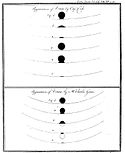Venus parallax during the 1769 transit de
Autor/Urheber:
Attribution:
Das Bild ist mit 'Attribution Required' markiert, aber es wurden keine Informationen über die Attribution bereitgestellt. Vermutlich wurde bei Verwendung des MediaWiki-Templates für die CC-BY Lizenzen der Parameter für die Attribution weggelassen. Autoren und Urheber finden für die korrekte Verwendung der Templates hier ein Beispiel.
Shortlink:
Quelle:
Größe:
2000 x 2000 Pixel (24703 Bytes)
Beschreibung:
The diagram shows the positions of Venus against the solar disk during the transit of 1769 June 4, as seen from Tahiti (Pacific) and Vardø (Norway), and compared with the path seen by a hypothetical geocentric observer. As can be seen, the Tahiti chord lies to the north of the Vardø chord due to the Tahiti observer's position on the southern hemisphere. For the Tahiti observer, Venus thus cuts a shorter chord across the Sun, allowing the parallactic shift to be measured by _timing_ ingress and egress (time could already be measured very precisely in the 18th cty). Furthermore, Venus appears to move quicker across the Sun for the Tahiti observer, because the Tahiti observer - being closer to the equator on the rotating Earth - travels through a longer arc during the observation. Thus, for the Tahiti observer ingress is later and egress earlier than for the Vardø observer - in addition to the other effect described above. Thus the parallax for each observer can be measured by timing ingress and egress, rather than using angular measurements. Combining parallax measurements of several observers at known locations on the Earth, Venus' distance can be triangulated.
Coordinates of Venus and Sun created with GUIDE 8 at twenty-minute intervals, plotted with a custom program.
Lizenz:
Relevante Bilder



(c) Klingon, CC BY-SA 3.0

(c) Klingon, CC BY-SA 3.0

(c) Klingon, CC BY-SA 3.0

(c) Klingon, CC BY-SA 3.0

(c) Klingon, CC BY-SA 3.0



(c) Hokuzai, CC BY-SA 3.0


(c) Andreas Kemnitz, CC BY-SA 3.0 de


(c) Andreas Kemnitz, CC BY-SA 3.0 de
















Relevante Artikel
VenustransitEin Venustransit, auch Venusdurchgang oder Venuspassage, ist ein Vorbeiziehen des Planeten Venus vor der Sonne. Die mit Fernrohr, manchmal auch freiäugig beobachtbare Erscheinung tritt in etwa 243 Jahren nur viermal auf, weil Venus- und Erdbahn ein wenig gegeneinander geneigt sind. .. weiterlesen
